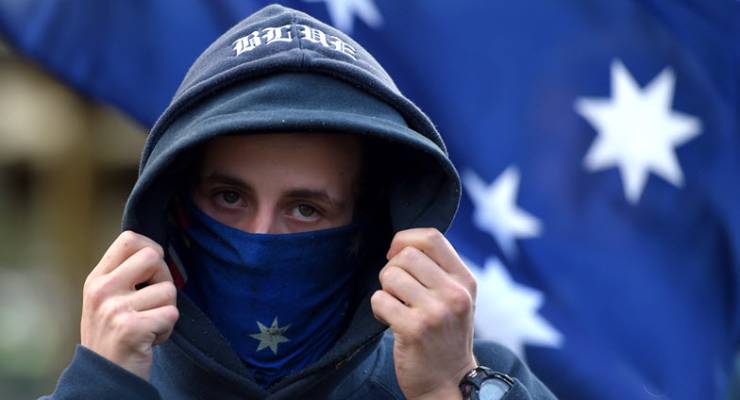
The US has been battered by far right violence in the last week. The shadow of the numbing, deadly antisemitic attack in Pittsburgh dimmed the focus on the inept attempts to bomb high-profile critics of Donald Trump and all but covered the murder of two black people by a white supremacist in Kentucky.
These events brought into chilling relief just where the creep of white supremacist rhetoric into a country’s mainstream eventually ends up. As Bernard Keane pointed out this week, in the UK, white terror suspects now outweigh any other group.
Meanwhile, in Australia, this year alone there have been neo-Nazis infiltrating the ranks of the Young Nationals (leading to series of resignations), a series of nationalists interviewed on Sky News (again and again), Senate speeches calling for a “final solution” on immigration and a motion explicitly referencing a white supremacist slogan voted up by the sitting government in the Senate.
As such, the question of how we respond to radicalisation and terrorist attacks from the far right is increasingly relevant.
Priorities
“I think there is a too much of a tendency to focus on the Islamic community and Islamic influenced terrorism rather than other types of violence, potentially from the far right, and the far left,” counter-terrorism expert Professor Clive Williams told Crikey.
“I think the far right has been emboldened by the Trump administration — we’re more likely to see the kind of attacks that recently occurred in Pittsburgh. I think that’s possible in Australia, and we don’t follow that kind of thing as well [as risks from Islamic communities],” he said. “Individuals from the extreme right can be quite competent at performing an individual attack. If you look at Anders Behring Breivik in Norway, he killed 77 people. He was a lone actor.”
Williams said that the counter terrorism budget was generous for what was a “relatively low risk” of a major terrorist attack — the growing threat comes from “lone wolf” style attacks.
“Major Al-Qaeda style attacks, using bombs or car bombs and bringing about large numbers of casualties require a lot of planning, testing and people involved — and in the current time it’s very hard to do that without alerting someone and being interdicted. The attacks that are more likely to get through are more low level, spur of the moment attacks, usually involving vehicles or knives.”
Scrutiny over collaboration
The over-emphasis on scrutiny of “at risk Muslim youths” has always been a flaw in the Countering Violent Extremism (CVE) programs — Australia’s primary method of targeting young people at risk of radicalisation — which has led to strange priorities, Dr Clarke Jones of the Australian Intervention Support Hub at Australian National University told Crikey,
“I was applying to run an intervention program in Victoria working with a Muslim community that arguably is one of the most in need and has had access to all sorts of vulnerable youth. We were told that this community was too risky to work with. I argue that it’s too risky not to support them in their youth programs,” he said.
“In another Victorian initiative to reduce youth violence … I was supporting the same community to gets funds to work on this project. We were told that we couldn’t get money because if we were involved it would have to come out of the CVE bucket,” he said. “This means that this community is only seen through the prism of violent extremism. Think of the message that sends. Imagine how that makes Muslim communities feel.”
“On the positive side, yes, they’ve made progress in understanding some of the underlying factors that lead young people into these kinds of groups, but with that knowledge, they still focus on CVE, rather than addressing some of those underlying factors,” Jones said. “In some ways, I think CVE contributes to the problem — it can be the CVE approach that drives kids to marginalisation, isolation and worse. When the solution is the problem, you need a new solution.”
Throwing money at the problem
The “multi-million dollar business” that is deradicalisation programs has long been seen as a flaw in counter terrorism circles.
Jones said funding was an issue for many community centres, so for purely financial reasons they often feel they have no choice but to accept money that is channelled via CVE.
Williams said the context of this newly emerging threat was a good reason to reevaluate the overall nature of counter terrorism spending (roughly $1.5 billion per year) in the country: “It’s time to do a review of the overall threat, the money we spend and how we spend it.”








Crikey is committed to hosting lively discussions. Help us keep the conversation useful, interesting and welcoming. We aim to publish comments quickly in the interest of promoting robust conversation, but we’re a small team and we deploy filters to protect against legal risk. Occasionally your comment may be held up while we review, but we’re working as fast as we can to keep the conversation rolling.
The Crikey comment section is members-only content. Please subscribe to leave a comment.
The Crikey comment section is members-only content. Please login to leave a comment.